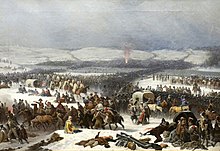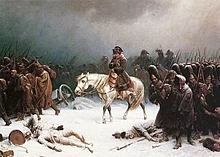Withdrawal (military)
![]()
The title of this article is ambiguous. For other meanings, see Retreat (disambiguation).
In military tactics, retreat or tactical retreat (correctly: evasion) refers to the battle-like disengagement from the enemy.
This is a predominantly orderly weaning movement. The flight, on the other hand, is disorderly, uncoordinated, partly aimless and/or haphazard, sometimes panic-stricken.
Evasion may be necessitated by an attack by superior forces if the pressure on friendly troops becomes too great. It is usually necessary when one's own troops are threatened with encirclement or the current front or position does not offer an optimal starting position for further actions (offensive as well as defensive), but on the other hand opens up good opportunities for the enemy (e.g. to close a front arc). Evasion is also used when an attacking force is unsuccessful and is ordered to end its attack and return to its initial position. Evasion is usually covered by a rearguard.
Evasion is also a combat action of a fighter platoon in a fighter fight from hiding or in a surprise encounter with even inferior enemy forces, in order to keep the initiative itself and not to be tied up in passive combat actions.
Regulated retreat under constant enemy action is often described as the most difficult military maneuver of all.
The mock retreat is a stratagem of war. It is already mentioned in the 36 stratagems, which were probably written in the 5th century: "Expect the exhausted enemy rested". Through a mock retreat, the French Normans won the Battle of Hastings on October 14, 1066 (Duke William the Bastard defeated the Anglo-Saxons under their king Harald II).
Mongol warfare also included mock retreats.

Napoleon's retreat from the Russian campaign across the Berezina River

Napoleon in retreat from Moscow (history painting)
Known examples
- In March 1917, German troops in the central section of the Western Front on the Somme withdrew to the heavily expanded Siegfried position in Operation Alberich. Beforehand, they largely devastated the cleared area and partially mined it. With this retreat, the Germans shortened the defensible front line and retreated to a line that was particularly defensible in many places due to the terrain relief.
- With the victory over the German troops on the front line before Amiens - Black Day of the German Army (August 8, 1918), the turning point in World War I was finally sealed and Germany's defeat was only a matter of time. On this day the Germans lost about 30,000 men, half of whom became prisoners of war, which made an impression on the Supreme Army Command (OHL). The staff officers demanded permission from Erich Ludendorff to withdraw, but he insisted on defense at all costs. The rigid defense he ordered would have allowed the Allied tanks (10 battalions of 360 British Mark IV heavy tanks, 2 battalions of 96 Mark A cavalry tanks, and 2 battalions of 90 French Renault FTs) to achieve even greater success; however, Ludendorff eventually agreed to withdraw the front.
- In 1934-35, the Chinese People's Liberation Army retreated thousands of kilometers before the Kuomintang troops. This retreat entered the founding myth of Maoism as the Long March.
- In May/June 1940, the British Army retreated across the English Channel to England during the Battle of Dunkirk. Its importance lies in the fact that it saved a large number of British and other Allied soldiers from German captivity. During the German Western Campaign, the northern French town of Dunkirk was the last port of evacuation for the British Expeditionary Force. The British and French managed to defend the bridgehead until over 330,000 Allied soldiers had been brought to safety in Operation Dynamo before the Germans captured the town. 40,000 Allied soldiers, mostly French, went into German captivity; the Wehrmacht captured 50,000 vehicles of all kinds and other heavy war equipment.
- The retreat from the northern Caucasus foothills in 1943 was one of the few military withdrawal operations by the Wehrmacht in which not all of the Army Group and all of its heavy equipment was lost.
Hitler repeatedly interfered in planned or ongoing retreat operations by his generals, believing he could make a difference by using holdout slogans or orders such as "to the last man" (or stone or drop of blood). This often led to formations being encircled in strongholds or hasty "last minute" (ordered or authorized or unauthorized) retreats. The Wehrmacht fought numerous retreat battles
- on the Eastern Front after the defeats in the Battle of Stalingrad (winter 1942/1943) and the Kursk Arc (summer 1943). The retreats ended in the Kessel von Halbe (southeast of Berlin) and in the Battle of Berlin.
- on the western front:
- since the Allied landing in Sicily in July 1943
- since June 1944 against the Allies who had landed in Normandy
- since August 1944, when the Western Allies had landed in the Rhone Delta
- 1945 at the failure of the Battle of the Bulge and Unternehmen Nordwind and from then on the whole width of the front; part of the retreat ended in April 1945 in the Ruhrkessel (in the Rhineland, the Ruhr area and Westphalia)
See also
- Great Retreat
- Cavalry#Tactics
- Withdrawal from Karánsebes
Questions and Answers
Q: What is a military withdrawal or retreat?
A: A military withdrawal or retreat is a type of military operation where forces pull back while maintaining contact with the enemy.
Q: Why would a military force retreat?
A: There are several reasons why a military force would retreat, such as to occupy ground that is easier to defend, to lead an enemy into an ambush, or to save the army from defeat.
Q: Is a withdrawal or retreat a risky move?
A: Yes, a withdrawal or retreat can be risky as it requires discipline to keep forces organized and not turn the retreat into a rout.
Q: What must be taken into account during a retreat to maintain a force's morale?
A: Care must be taken so a retreat does not damage a force's morale.
Q: Is it necessary to maintain contact with the enemy during a military withdrawal or retreat?
A: Yes, it is generally necessary to maintain contact with the enemy during a military withdrawal or retreat.
Q: Could a retreat be used to lead the enemy into an ambush?
A: Yes, a retreat can be used to lead an enemy into an ambush.
Q: Does a military withdrawal or retreat mean complete disengagement from the enemy?
A: No, a military withdrawal or retreat does not mean complete disengagement from the enemy as forces are still expected to maintain contact.
Search within the encyclopedia